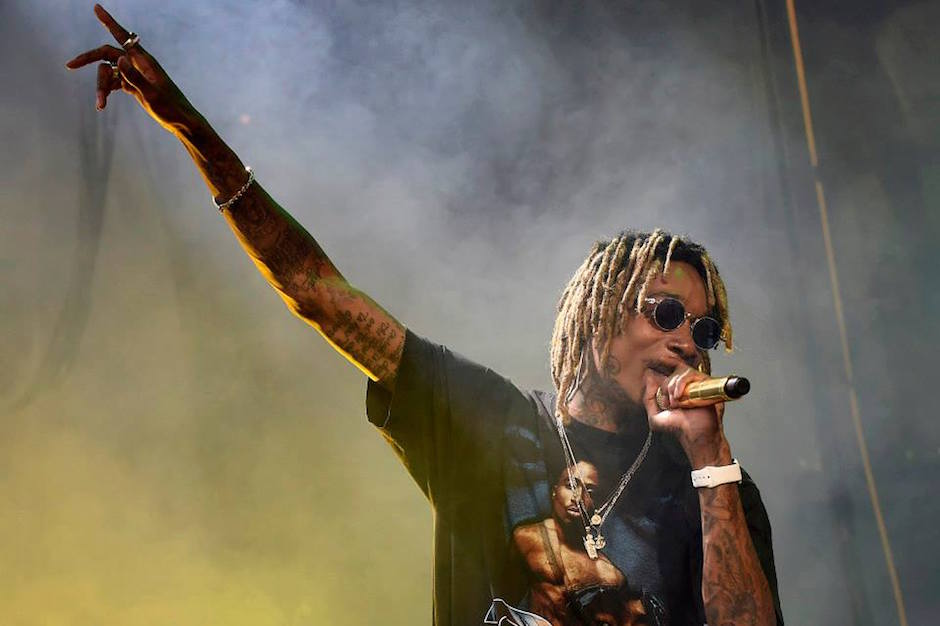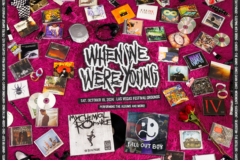If anyone in the almost completely 21-and-under crowd of 15,000 at Long Island’s Nikon Jones Beach Theater on the evening of June 25 was still surprised that pop-punk heroes Fall Out Boy were touring with rapper Wiz Khalifa, the former’s drummer Andy Hurley hammered home the final nail in the coffin. Just over halfway through FOB’s set of anthems to celebrate underdogs, mourn romances, and promise redemption — “For the next one and a half hours, let’s fight back!” roared singer Patrick Stump, before introducing “The Phoenix” — he broke into a face- and genre-melting drum solo with snippets from G.O.O.D. Music’s “Mercy” and Fetty Wap’s Song of Summer (or at least Spring) contender “Trap Queen”, even dropping some of Deadmau5’s gurgling wubs into the mix. If the summer of two years ago was unfortunately defined by Brad Paisley and LL Cool J’s mildly offensive red-headed stepchild of country and rap, “Accidental Racist,” this summer would be soundtracked by the “Boys of Zummer” — Wiz Khalifa and FOB’s co-headlining summer tour — a reminder that pop-punk, emo, and rap are not so far apart.
About six months after their joint tour was announced in January of this year, Good Charlotte and Waka Flocka Flame blew minds even further into the past with their collaboration for the animated arcade game throwback movie Pixels, “Game On.” “This is not a game,” Madden brothers Joel and Benji taunt in sing-song over a bleacher-stomping lockstep beat, twitchy little power chords like the pixelated images onscreen. “I go harder and harder,” Flocka spits some verses later. “You gon’ show respect when you talking to me!” Indeed, the 29-year-old wannabe presidential candidate tells SPIN if it weren’t for him, these sorts of cross-genre collaborations would never have happened. “I feel like I’m the reason why you see a lot of hip-hop artists in different genres,” he says, referring to his tour and collaboration with cake-throwing, champagne-spraying producer and DJ Steve Aoki. “We opened it up to EDM. I did it so organically that people were like, ‘What the fuck?’ So I think people are trying to jump in new things, like I did.”
We’re still waiting on his reported rap-meets-EDM album Flockaveli Psychotics, but in the meantime, he and his FKA Good Charlotte collaborators are continuing in a long tradition that actually started years ago. But first, some clarifications: the stadium-selling-out combination of emo and rap is separate from the related-in-name emo rap, which ten years ago was most associated with rappers like Atmosphere’s Slug but now has become attached more with Kid Cudi and Drake, who headlined Bamboozle in 2010 (and got flack for delaying Paramore’s set by 30 minutes). “Emo” itself is a slight point of contention for Stump and Co., who shy away good-naturedly from being labeled as such. “We benefited from it but we were in the wrong place at the wrong time,” he explains to SPIN, pointing out that FOB’s most recent album, American Beauty, American Psycho, marries hip-hop and guitars. “We were doing our thing and got swept up in it. Musically we were trying things that just really weren’t cut of that cloth, that whole scene, and it kind of gets forgotten in the annals of history because the singles were chosen probably because they fit that mold.”
This collision of genres that give a voice to kids these days mostly originated on the Warped Tour, which featured rappers and all the punk kids performing side-by-side. “Warped Tour is ten percent hardcore of anything,” says festival founder Kevin Lyman, adding that “breakaway collaborations” such as the aforementioned tend to happen in cycles (ahem, “Numb/Encore”). “If you’re part of the ten percent hardest-core punk bands, you don’t want to go on Warped Tour; if you’re part of the ten percent hardest-core rappers, you don’t want to go on Warped Tour. It’s for the 90 percent of people who listen to their music on shuffle and just want to go out and have a good day.” He adds that the festival appeals to more “creative” rhyme-slingers — like Public Enemy and Minneapolis record label Rhymesayers (including P.O.S. and Grieves) — who have been on Warped Tour before with the intention of expanding their fan bases regardless of their demographics, not to mention having a damn good time.
As such, certain left-field, rap-focused artists have raised hackles with the 21-year-old festival’s traditional crowd, like RiFF RAFF, whose billing was so contentious a Change.org petition was launched to remove him (and, to be fair, Kosher Dillz, who is also addressed in that same petition). “Find something better to protest, like seal pups in Antarctica,” Lyman comments, laughing. “If someone would stay home because of that, I’d give them a lot of credit for standing for something; but most of these people don’t stand for anything online. When I announced Eminem way way back when, it was the beginning of the death threats. They were like, ‘We’re going to kill Eminem!’ and then just stood there and ended up liking him.”
Such virulent distaste for other genres didn’t seem to present a problem at the FOB and Wiz Khalifa double-header at Jones Beach, where much of the young crowd seemed to fall into three categories: those who knew all the words to “Black and Yellow” and “See You Again,” those who wore FOB T-shirts and watched Wiz’s onstage antics with bemusement/boredom until Pete Wentz took his power stance behind the mic, and those who seemed to actually be enjoying themselves equally during both sets. “They’re living their life on shuffle, so they’re probably more open-minded,” Lyman explains of the last bunch, referring to younger music fans’ predilection for diverse music tastes.
Between sets, the bulk of the attendees — about “98%” white, according to an unscientific scribble in my notebook — seemed to mill about in the food and beverage area as if it was a high school food court, wearing denim cutoffs and crop tops (girls) or cargo pants and Hollister shirts (guys). There were few, if any, parental figures in sight. When Wiz’s crew threw out giant inflatable joints during “Young Wild and Free,” the message wasn’t quite as innocuous as it seemed: at least 50 attendees were hospitalized later that evening due to drug and alcohol use, even though the latter wasn’t served at the venue. One girl who looked to be about 16 years old announced loudly and wild-eyed to her friends outside the bathroom, “I smoked seven joints before I came here!” If festivalgoers now value the “experience” — i.e. doing drugs, having sex, and drinking alcohol — over whatever band or DJ is playing in front of them, it seemed largely reinforced by the Jones Beach crowd.
Regardless of just how high everyone may have been, the music did seem to bring disparate fans together, which is something that Stump noticed. “At this point in time in pop music history, hip-hop and rock music are way closer buddies than rock and country,” Stump told SPIN the day before hitting the road on the “Boys of Zummer” tour. “Even though that’s guitars, it’s more of a surprising collaboration, because I feel like you talk to any hip-hop musician, they’re listening to rock; talk to any rock musician, they’re listening to hip-hop. I don’t know a single rock musician, from metal guys to indie rock guys, who aren’t paying attention to what Kanye’s doing.”





